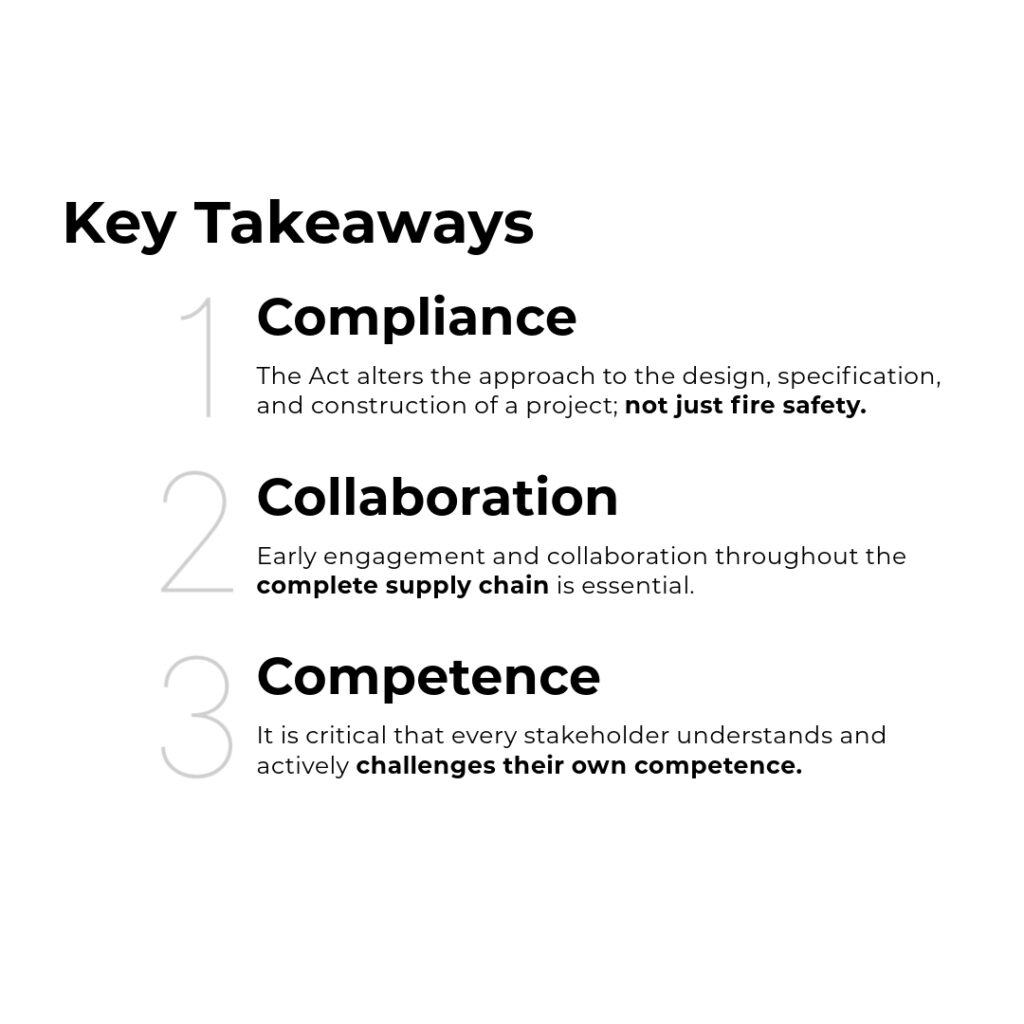
The construction industry may have experienced one of the most significant changes for a long time. The Building Safety Act (BSA) which took effect in October 2023 will affect Architects, designers, construction companies, and developers who are at the forefront of these transformations.
To truly understand and express the importance of this new regulation, Logic partnered with Selo (https://selo.global/) to host an event specifically relating to the Building Safety Act, below are the Key takeaways for the Architects, Developers and Construction Companies to consider.
Architects and designers play a pivotal role in the construction process, and the BSA demands a fresh approach to their work.
Early Collaboration is Vital
The BSA and gateway 2 requires designs to be submitted as a complete pack rather than being delivered sequentially. This means it is important for architects and Designers to collaborate early with contractors and manufacturers.
Competence is Key
Understanding your competence and challenging it is crucial. The BSA demands a higher level of competency, particularly in the design and specification phases. Architects and designers must continually strive to improve their skills and knowledge. Architects and designers should look to improve their knowledge of each specific package, this will ensure that they can confidently challenge the competence of manufacturers and suppliers.
Complete Package Submission
Unlike the previous approach, where the design was iterative, the BSA requires architects and designers to submit a complete information package at Gateway Two. This shift in design delivery calls for a more comprehensive understanding of systems and design elements from the outset. Nyasa Beale from Scott Brownrigg advised that Architects will need specialist help from manufacturers to complete this package.
Construction companies are facing significant changes in the construction landscape with the BSA, which brings both opportunities and challenges.
Increased Certainty in Design
The acceleration of the design and specification process means project designs should be more complete before works commence on site. This increased certainty in design is a welcomed change for contractors. This more comprehensive and finalized design stage will help contractors minimize unexpected changes and costly disruptions during construction.
Commercial Viability Considerations
Longer pre-construction periods and the 12-week minimum review period at Gateway Two may lead to commercial viability issues due to potential delays. Construction companies should be prepared to adapt to these changes. The Building Safety Act introduced a significant increase to the design stage. The longer pre-construction periods mean that contractors will need to allocate additional time and resources to project planning and design. This may result in increased upfront costs, including extended feasibility studies, design development, and financing arrangements.
Collaboration is the Key
The BSA encourages early collaboration among all stakeholders. By working together, construction companies can reduce wastage costs, ensure compliant installations, and achieve better results. Throughout the whole event, the emphasis was on everybody collaborating to be able to create a safe building right from design, through to completion. The Building Safet Act encourages early collaboration among all stakeholders. By working together with designers and manufacturers, construction companies can reduce wastage costs, ensure compliant installations, and achieve better results in the long term.
Developers are at the forefront of market changes due to the BSA, and understanding its implications is critical for continued success.
Higher Quality Overall
With this new comprehensive approach to design, compliance, and construction buildings and developments should require lower maintenance costs and fewer unforeseen issues, ultimately the value of the property will be enhanced.
Upfront Cost
Developers must be prepared for more cost upfront during the Preconstruction stage. Given the stringent requirements of the BSA and the Gateway 2 process, more work is required before commencement on site, with these extended project timelines, developers will have to wait longer before seeing a return on investment.
More Successful Results
Tom Gilbert said that ‘a change in culture is needed to design and build, rather than build and design.’ The design fully then build approach, will lead to reduced wastage costs and compliant installations first time. The BSA should set in motion the much-needed improvements in competency across the industry, both from the client side and during the construction process.

The seminar was very positive from all parties, despite many unanswered questions. It will be a learning curve to understand all the changes and the many challenges that everyone will have to face from the Building Safety Act. This is why it will be increasingly important for early collaboration from the whole industry to work things out together. However, despite the challenges that face us, it is clear there is a positive cultural change towards building a safer future.
As the construction industry adapts to the changes brought on by the Building Safety Act, industry professionals must remain adaptable, collaborative, and competent. Early engagement and collaboration are the keys to successfully navigating the changes that lie ahead. With a focus on safety, compliance, and improved build quality, the BSA paves the way for a safer and more secure built environment.